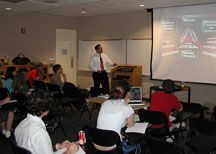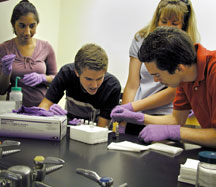Learning the Value of Science: Incoming Summer Interns Get
a Crash Course on Grant Funding
By Jennifer O'Sullivan
How do you imagine a group of 16- and 17-year olds might
spend a million dollars? Twenty-three high school juniors
and seniors came up with their own answer at a class on federal
funding for basic science held on May 5 at The Scripps Research
Institute.
As part of the eight-week Spring Enrichment Tutorials, which
serve as a precursor to the Summer Research Internship Program,
selected high school students attend seminars led by doctoral
candidates on a variety of biomedical research topics, including
virology, drug development, cancer biology, forensics, and
funding.
In last week's tutorial, "Grants & Money," three Scripps
Research faculty members pitched their respective research
proposals to the group, which became a mock NIH committee
charged with deciding how to distribute $1 million in grant
money.
"This is one of my favorite tutorials to lead," says fourth-year
graduate student Byron Purse, who has also taught "Combinatorial
Chemistry" and "Drug Development & Diseases" classes in previous
years. "It addresses important issues in the provision of
funding for science and really highlights the ambiguities
in choosing where money can be spent most effectively. I think
that the students learn more by making a mock funding decision
than by listening to us lecture—and they have more fun,
too!"
Let the Games Begin
Purse began the "Grants & Money" class with a brief overview
of how much the government spends on scientific research and
what types of projects are funded, characterizing the process
as one which is highly competitive and which requires researchers
to produce quality research results and aggressively pursue
funding. He then introduced the investigators—Phil Baran,
assistant professor in the Department of Chemistry, Gary Siuzdak,
associate professor in the Department of Molecular Biology
and director of the Center for Mass Spectrometry, and Velia
Fowler, professor in the Department of Cell Biology—
who each had 20 minutes to present a proposal, budget, and
preliminary results.
Baran presented first, speaking passionately about his focus
on the total synthesis of natural products, and its value
for developing future anticancer and antiviral compounds.
Describing chemical synthesis as "molecular construction work,"
Baran appealed to the group to invest in his and his colleagues'
pursuit to "make the penicillin of tomorrow." He then showed
a slide of his lab group, offering "not just a year of work,
but one and a half years. [These lab members] will not see
the light of day," he pledged entertainingly.
Next up was Siuzdak, who proposed research focused on predicting
disease rather than developing cures. Beginning with an overview
of the technology, Siuzdak described a project using mass
spectrometry to screen newborns for certain molecules that
predict disease. The resulting information would enable caretakers
to control or prevent these conditions in the children. Siuzdak
incorporated several visual aids, including a mass analyzer
taken from an instrument which, he joked, "brings the cost
of this lecture alone to $400,000."
The final speaker of the day was Fowler, who described her
research in cardiac muscle development in mice and proposed
investigating the cause of aborted heart development. The
work, she said, has medicinal implications for understanding
sudden cardiac arrest (also called cardiac hypertophy) in
humans.
From Federal Funding to Forensic Science
The students then broke into three small groups mediated
by Purse and fellow graduate students Liam Palmer and Trevor
Dale to decide how to distribute the $1 million in grant money
among the three proposals, which requested from $500,000 to
$800,000.
In the end, the students agreed to fully fund Siuzdak's
proposal and were generally split on whether the remaining
funding should go to Fowler or Baran.
I caught up with the students at the following week's forensics
tutorial and asked how they had decided which proposals to
fund.
"We gave most of the money to [Dr. Siuzdak]," said Hena
Din, a junior at University City High School. "His project
seemed more realistic because it was directly helping newborns."
Kelcie King, a senior at Vista High School added that "the
way they presented their proposals was really important. [Siuzdak]
did a good job explaining the research that was already in
progress."
Purse, who has now led the Grants & Money class three times,
said the students typically prefer to fund projects likely
to lead to tangible benefits for humanity. He also notes that
they are tough critics.
"If the professor doesn't put forth a clearly defined research
problem with convincing plans to solve it, the students generally
won't fund it," Purse observed. "It's tough for the professors
because we only give them 20 minutes and the students have
only high school science backgrounds. But this really serves
to highlight the importance of effective communication."
Major—albeit hypothetical—funding decisions made,
the group has moved on to a mock crime scene constructed by
grad students Katie Marcucci, Desiree Thayer, and Sarah Voytek.
In small groups, students rotate between fingerprinting, blood
typing, and thin layer chromatography analysis stations and
will use the evidence they gather to name one of three suspects
as the murderer.
Next week, the group moves on to the structure of biomolecules
and the visualization of molecules, all a prelude to summer
when the students will become part of a real research team
in a Scripps Research lab.
Send comments to: delasol@scripps.edu

|

Assistant Professor Phil Baran outlines
the science and technology of total synthesis for students
at the May 5th spring enrichment tutorial. Photo
by Jennifer O'Sullivan.

High school students (from left) Allyea
Ally, Paul Bilinski, Kelcie King, and Michael Comstock perform
TLC analysis as part of a forensics lab. Photo
by Jennifer O'Sullivan.
|

